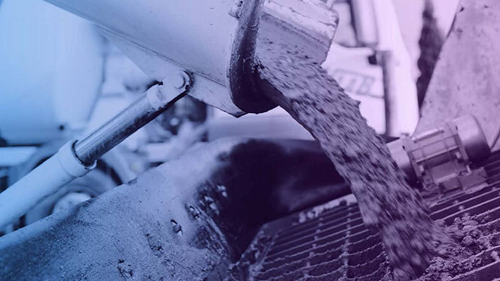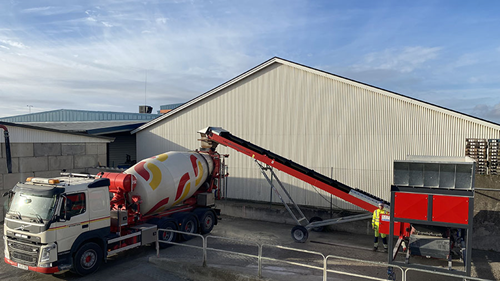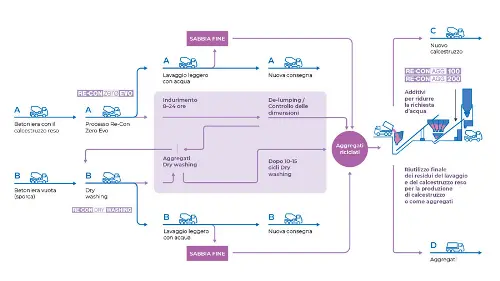

RE-CON AGG technology makes it cheaper and easier to use sustainable raw materials in concrete
Enhancing sustainability and efficiency in concrete production with RE-CON AGG technology
RE-CON AGG technology tries to tackle the shortage of high-quality natural sand and gravel used as raw materials in concrete production. By mitigating the slump loss, this range of admixtures help reducing costs, environmental impact, and ensuring high-performance concrete.

The USGS also published a report back in 2011 called “Aggregate Resource Availability in the Conterminous United States, Including Suggestions for Addressing Shortages, Quality, and Environmental Concerns” by William H. Langer. In this report, several geographical areas in the United States were identified as having a shortage of natural aggregates: the Coastal Plain and Mississippi embayment, the Colorado Plateau and Wyoming Basin, the glaciated Midwest, the High Plains, and the non-glaciated Northern Plains. Since its publication in 2011, an average of 860 million tons have been extracted each year according to USGS statistics.
The shortage of natural aggregates and sand is also a global issue. The United Nations Environment Program (UNEP) published a report in April 2022 called “Sand and Sustainability: 10 Strategic Recommendations to Avert a Crisis”. The report states that the global use of sand has tripled in the last two decades to reach 50 billion tons being extracted globally each year. This is enough to build a wall 27 m wide and 27 m high across planet earth. The report concludes that continued uncontrolled extraction of sand at the current rate is unsustainable for both social and environmental reasons.
This insatiable hunger for sand and gravel is putting the construction and concrete industries under pressure to find local high quality raw materials. The natural sources of sand and gravel are geological formations that are not always located within a short distance of where they are needed, so transport is becoming a growing cost and environmental challenge.
The market is increasingly focusing on the environmental impact of concrete as a building material. This has led to concrete producers starting to oversee their operations from a Life Cycle Analysis perspective in which the EPD (Environmental Product Declaration) states the Global Warming Potential of equivalent CO2 (often stated over 100 years as GWP100) for a given concrete mix design, and this value is declared to the buyer. The biggest motivator to finding alternatives to remote natural resources is, perhaps, still the cost awareness caused by rising fuel costs for transport. However, this may change when the cement industry implements environmental actions such as Carbon Capture and Portland Clinker replacement on a much larger scale; the relative environmental impact of the sand and gravel in a concrete mix design can then be expected to be higher. After all, around 60-70% of the volume of concrete is made up of coarse and fine aggregates (Sand and Gravel).

What are the alternatives to natural sand and gravel and what effect do they have on concrete?
Since high-quality sand and aggregates are not always available in the regions where they are most needed, concrete producers may be forced to use sand containing impurities (e.g. clays) or manufactured sand with higher fines content and increased voids content due to a less rounded and smoother particle shape.
The increasing shortage of natural sand and gravel is also a driver towards utilizing more and more recycled concrete aggregates in new concrete to increase the rate of circularity of material use. The European Commission issued the Waste Framework Directive in 2008 with the aim of reaching 70% recycling of construction and demolition waste by 2020. In 2018, the average re-use in the European Union was around 50%.

The focus on lowering the carbon footprint of concrete means secondary cementitious materials, such as fly-ash, slag or natural pozzolans, are being introduced into more and more concrete mix designs in increasingly higher ratios.
All these new materials (manufactured sand, recycled concrete, supplementary cementitious materials) now entering the concrete production sector have one thing in common: they are more “thirsty” than natural sand and gravel. By this we mean that, to achieve the same workability, they consume much more water and admixtures than natural aggregates and the pure Portland clinker cements used in the past.
Why is this a problem? There are two main factors involved: firstly, it is very difficult for a concrete producer to be able to guarantee the flowability of concrete delivered to a building site if the concrete absorbs high amounts of water and water reducing admixtures during transport from the mixing plant to the customer’s building site. This restricts the ratios in which these alternative materials can be used. Too high slump loss may lead to whole loads being discarded by the end user and reclaiming and waste cost is increased for the concrete producer. Secondly, if concrete producers add more water in the mix, they need to add more cement to guarantee the same strength and durability specified by the customer. More cement means the concrete will have both a higher cost and a higher carbon footprint.
RE-CON AGG technology helps mitigate slump loss through a unique combination of polymer technology (you can read more in the following pages of this newsletter). In principle, by using RE-CON AGG in combination with a superplastizicer from the DYNAMON range, the workability of fresh concrete (slump) can be maintained for up to 90 minutes, even when using highly demanding concrete aggregates.
The benefit for the customer lies in reduced production costs, lower environmental impact of the concrete mix design, and higher quality and predictability of the properties of fresh concrete transported for 60 to 90 minutes to the customer without losing slump, as shown in the graph below.
To summarise, RE-CON AGG technology is a big help towards achieving both important environmental goals and reducing the cost of concrete production with more sustainable raw materials.
Find out more about Mapei solutions for the concrete industry at: https://www.mapei.com/cis/en/home-page















